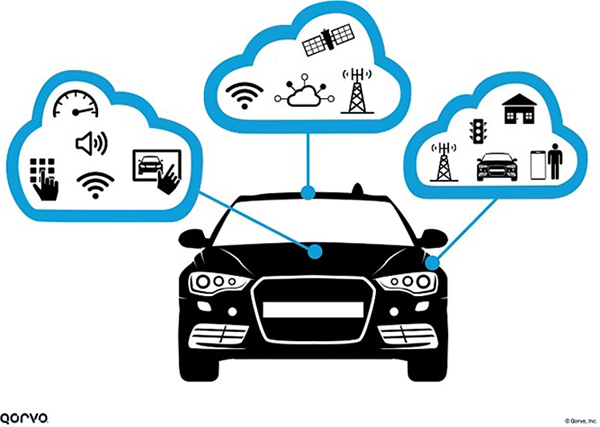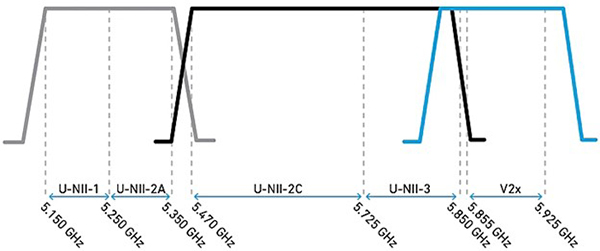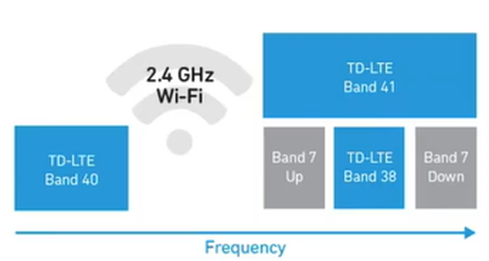Steering Clear: Vehicle-to-Everything Designs with Seamless Communication and No Interference
April 1, 2021
Vehicle-to-Everything (V2X) is a term that encompasses a vehicle technology. It enables the automobile to communicate with the environment around it, such as bicycles, motorcycles and other vehicles. To make this work, information from sensors and other sources, inside and outside the vehicle, travel by means of low-latency, high-reliability links, that will ultimately pave the way to fully autonomous driving. See Figure 1.
 Figure 1: The connected vehicle
Figure 1: The connected vehicle
A major selling point for V2X communication is safety. V2X communication technology promises to lower the number of vehicle accidents, which will also lead to a reduction in associated injuries and deaths. An NHTSA study found that connected vehicle technology has the potential to reduce up to 80% of crashes where drivers are not impaired. In fact, by 2024, automotive industry bodies (the National Highway Traffic Safety Administration and the Society of Automotive Engineers) are expected to require vehicles to offer certain V2X features to receive a full, five-star safety rating. This technology will also greatly improve traffic management. By leveraging data from Road-Side-Units (RSUs) and On-Board-Units (OBUs), V2X technology can connect cars to other cars and pedestrians, drivers and bicyclists to traffic lights. Information on traffic patterns, lights and other vehicles can be relayed to the car through Wi-Fi or a cellular-connected vehicle's infotainment system or even through an app on the driver’s phone, allowing the driver to adjust to safer and more efficient driving patterns. This can lead to greener vehicle performance through the reduction of harmful CO2 emissions, as well as lower fuel costs.
There are many components of V2X: see sidebar "Vehicle Communications Acronyms + Meanings." Enhancing V2X and bringing it to market is often a top priority for many car manufacturers because of many safety benefits, as well as other communication benefits for the consumer. However, to design a robust system solution, we need to first understand the intricacies and challenges of V2X.
Cellular-V2X (C-V2X) brings several vehicle engineering challenges such as wireless coexistence caused by multiple radios inside and outside the vehicle. The new and future automobile will have many radios inside to address safety, security, and entertainment trends. These radios will lead to co-existence challenges. One obvious coexistence challenge is Dedicated Short-Range Communications (DSRC) and C-V2X (Cellular operators licensed carrier), which communicate using the same 5.9 GHz band. Additionally, 4G LTE, 5G and Wi-Fi all have bands closely aligned with the 5.9 GHz frequency range.
Future automobile trends
As mentioned, there are numerous connectivity technologies in the connected vehicle. These are uniquely different and must not interfere with each other’s signal quality in order to achieve seamless communication. These technologies include:
- V2X (DSRC and C-V2X) used for automobile safety
- 4G/5G cloud connectivity for in-vehicle OEM services such as remote diagnostics, over-the-air software updates, teleoperation and more
- In-vehicle 4G/5G cloud connectivity entertainment
- Wi-Fi
- Bluetooth®
- Satellite digital audio radio services (SDARS)
Vehicle Communications Acronyms + Meanings
Vehicle-to-Everything (V2X): a technology that allows vehicles to communicate with moving parts of the traffic system around them.
Vehicle-to-Infrastructure (V2I): communication that allows vehicles to share information with traffic system components such as overhead RFID readers and cameras, traffic lights, lane markers, streetlights, signage and parking meters.
Vehicle-to-Pedestrian (V2P): communications between a vehicle and a pedestrian or multiple pedestrians within close proximity.
Vehicle-to-Network (V2N): communication with, and access to, networks for cloud-based services.
Cellular Vehicle-to-Everything (C-V2X): allows vehicles to communicate via mobile cellular connectivity to send and receive signals from a vehicle to other vehicles, pedestrians or to fixed objects such as traffic lights in its surroundings.
Dedicated Short-Range Communications (DSRC): one-way or two-way short-range to medium-range wireless communication channels specifically designed for automotive use and a corresponding set of protocols and standards.
How high-selectivity filter solutions tackle co-existence challenges
Let’s examine some of the ways filter technology solutions help address V2X coexistence with Wi-Fi and cellular spectrum. Here are three of the top challenges:
- V2X and 5 GHz Wi-Fi
- Wi-Fi 2.4 GHz and Cellular bands 7, 40, 41
- Electronic Toll Collection (ETC) and V2X
V2X Coexistence Challenge with 5 GHz Wi-Fi
As shown in Figure 2, the Wi-Fi 5 GHz Unlicensed National Information Infrastructure 3 (UNII 3) band overlaps with the 5.9 GHz V2X band. For these two radios to operate without interference, a filter is required. This filter needs to have very steep attenuated out of band edges near the 5.855 GHz area to ensure the V2X and Wi-Fi UNII 3 signals do not cause communication interference. Additionally, the UNII 2C receive band noise can cause receive signal desense. Desense, in this case, is the design challenge of interference among wireless devices with multiple radios operating simultaneously. These signals could interfere and compromise the receiver’s sensitivity of being able to receive weak signals. For example, if a transmit signal is not properly isolated from the receiver, it could interfere with the receive path signal, thus causing desense. Therefore, an additional filter is required to reduce the noise on the 5 GHz receive signal.
 Figure 2: 5 GHz automotive coexistence of V2X and Wi-Fi
Figure 2: 5 GHz automotive coexistence of V2X and Wi-Fi
Wi-Fi 2.4 GHz Coexistence with Cellular Bands 7, 40, and 41
A second coexistence issue seen in V2X is the interference between cellular bands 7, 40 and 41 and the 2.4 GHz Wi-Fi band. Shown in Figure 3, you can see that Wi-Fi 2.4 GHz is positioned between and close to these TDD (B40 & B41) and FDD (B7) signals. When Wi-Fi 2.4 signals are transmitting and receiving in the vehicle, filters must be employed to make certain users on the cellular bands can continue communications without interruption. Again, this is achieved using BAW filter technology – both in discrete form and inside highly integrated Qorvo modules.
 Figure 3: Coexistence between cellular and Wi-Fi 2. 4 GHz band
Figure 3: Coexistence between cellular and Wi-Fi 2. 4 GHz band
V2X Coexistence Challenge with Electronic Toll Collection Radios
Beyond the above-mentioned coexistence challenges, there is the issue of V2X interfering with Electronic Toll Collection (ETC) services. ETC services in China and Europe operate very closely to the V2X bands. As shown in Figure 4, the European V2X band is only 40 MHz from the European ETC band. The European V2X spectral emissions specification cannot be met without incorporating a notch filter at the input of the V2X front-end module, which allows the ETC to coexist with V2X.
The same issue exists in a China ETC application. The V2X China band is only 65 MHz from the downlink of the ETC band. A notch filter must be employed on the front-end input to reduce spectral emissions to properly coexist. In the future, the China ETC band may likely become even closer to the V2X band because China carriers are seeing possible capacity constraints due to bandwidth. Discussions on this topic are currently taking place in China.
 Figure 4: Electronic Toll Collection versus V2X bands
Figure 4: Electronic Toll Collection versus V2X bands
What is the best filter technology to tackle these V2X coexistence challenges? Qorvo has helped numerous companies leverage Bulk Acoustic Wave filters for these type of applications as we will outline below.
Bulk Acoustic Wave (BAW) filters
Avoiding interference in such cases calls for high-performance RF bandpass filters that can operate at high frequencies. BAW is well suited for this high frequency operation. BAW filters also provide steep skirts to prevent signals from bleeding into adjacent bands and enable low insertion loss across the passband to sustain output power and maximize signal range.
The automotive environment requires reliable operation over the life of the vehicle, under extreme temperature and humidity as well as vibration (Quartz crystal filters will not work here). Employing BAW filters in these challenging automotive conditions means engineers can now replace larger, harder to implement filter technology.
BAW filters uniquely possess the needed characteristics and will have all the capabilities required for the 5.9 GHz band. Such filters provide the necessary steep skirts and high quality (Q) factors of up to 3,000, with a far smaller footprint than traditional ceramic or dielectric filters. BAW filters provide precise selectivity and small size and are perfectly suitable for advanced RF applications in vehicles. These filters are typically used for applications above 1.5 GHz where high performance is required. Additionally, the technology is fundamentally capable of working at frequencies up to 7 GHz and beyond.
A Front-end Solution
Qorvo offers BAW filter technology in discrete form and in modules. The Qorvo V2X Front-end suite has the first Band 47/Wi-Fi BAW coexistence filter that enables Wi-Fi coexistence with the V2X 5.9 GHz band. This provides the ability to establish reliable links between vehicles and their surroundings. In addition, it includes two integrated front-end modules (FEMs) that support C-V2X and DSRC systems, a digital step attenuator, transmit/receive switch, and low noise amplifier. This front-end is chipset agnostic and enables a reliable V2X link with sufficient transmit linear power and excellent receive performance in a Wi-Fi environment where Wi-Fi and V2X coexists.
There will be much more to come on this topic as we progress along the path of safe driving via high tech electronics innovations in road vehicles with wireless technology advancements. If you are interested in obtaining the best technical understanding of V2X, then watch this video How to Mitigate Spectrum Challenges Associated with V2XA.
The Bluetooth® word mark and logos are registered trademarks owned by Bluetooth SIG, Inc. and any use of such marks by Qorvo US, Inc. is under license. Other trademarks and trade names are those of their respective owners.
Have another topic that you would like Qorvo experts to cover? Email your suggestions to the Qorvo Blog team and it could be featured in an upcoming post. Please include your contact information in the body of the email.
